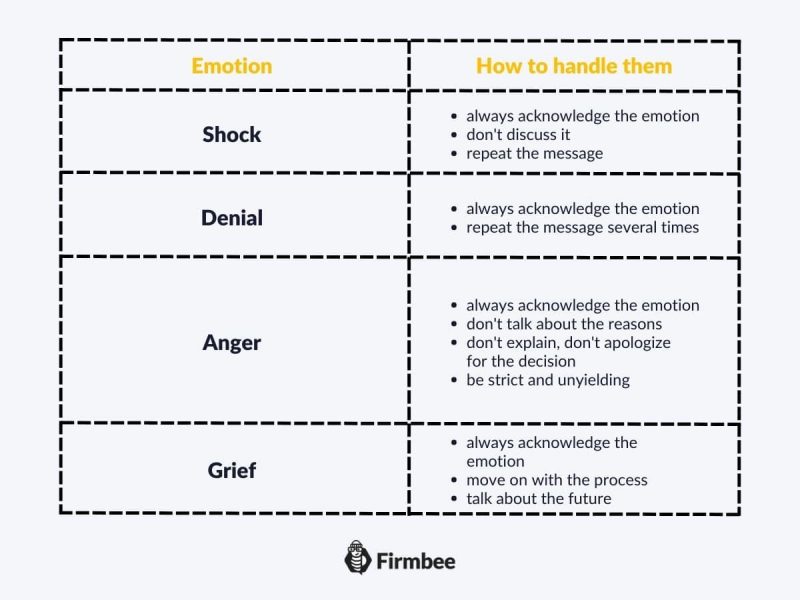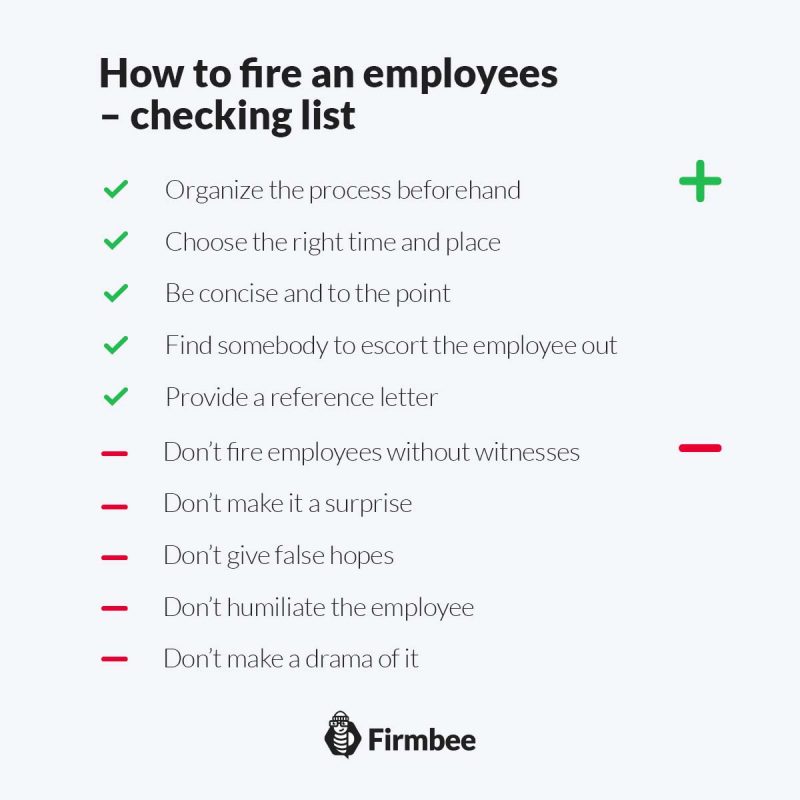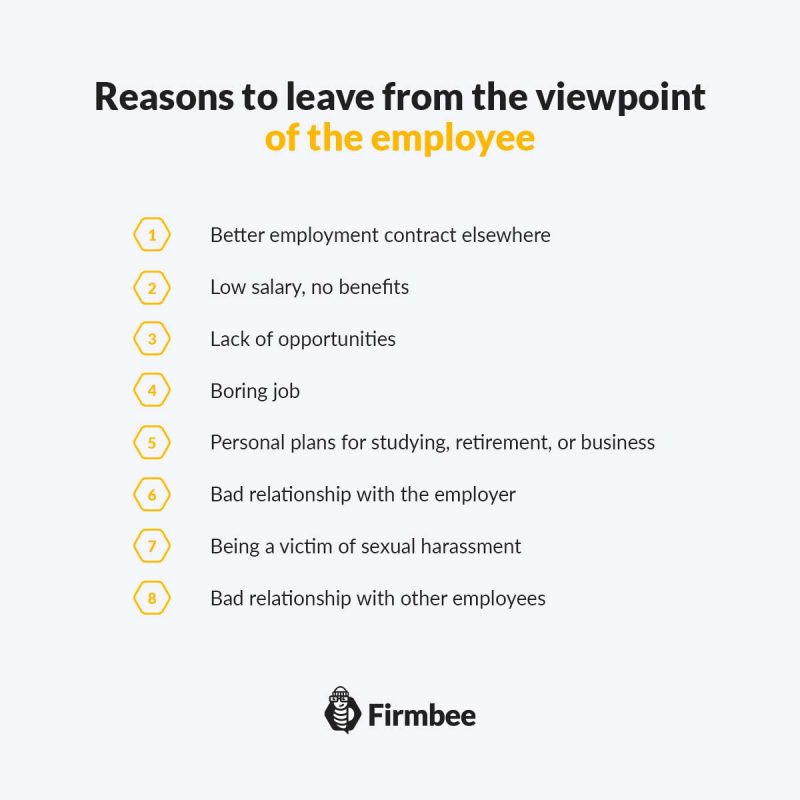Employee termination process – do you know how to conduct it? Is it easy to fire an employee that is dishonest and lazy? What are the reasons for employee termination process? What are the main types of employee termination? Do you know how to start an employee termination process? How to make sure that termination is valid and how to avoid lawsuits for wrongful termination? What are the crucial steps of employee termination processes? Read the article to find out more.
Employee termination process – table of content:
- Reasons for employee termination process
- Types of employee termination
- What to do before an employee termination process
- Steps of employee termination processes
- Summary
Reasons for employee termination process
There are only two real reasons for termination employees, one is due to economic reasons, and the other is firing for a cause. In most of the cases managers have to fire an employee because he or she is creating problems in the workplace.
To fire somebody without risking further legal problems the manager has to be sure to have a valid, proven reason for such action. Firing can never be done on the spot, out of anger or for other personal reasons. Generally there are several reasons that can be documented and form acceptable set of reasons for termination of the employment.
Among those reasons are:
- physical violence, aggressive, abusive behavior towards other employees
- criminal behavior that may include either theft or revealing of company’s secrets
- discrimination, harassment, sexual harassment
- problems with timekeeping and attendance (absenteeism, tardiness)
- insubordination and breaking of company rules
- lack of competence, low productivity, poor quality of work, indolence
Most of the reasons above directly influence the functioning of the company. Other reasons additionally put other employees at risk and they are important because of the health and safety regulations. If the behavior of your employee matches with one of the categories above you not only can, but you really should fire the employee without hesitation. You just have to remember that you cannot simply fire anybody as you see fit because you may have to prove your reasons later on – in court.

Types of employee termination
From the legal perspective there are four distinctive types of employee termination and all of them bring different results both for the company and the employee. Those types of employee termination are: voluntary, involuntary, employment at will, and mutual termination.
Voluntary termination. This type of termination happens when the employee decides to leave the company. The employee may find the reasons after the termination process, but there is no rule here, since the reasons may be either professional (negative work environment, lack of opportunities, remuneration) or personal (family issues, health problems).
Involuntary termination. This type of employee termination is the reverse situation from the above, here the company decides to remove the employee from employment. This type of termination has to be well-thought-out and conducted accordingly to the company rules to avoid any probable legal actions from the side of the employee.
Employment at-will. Here we describe a specific type of termination that is related to the form of the agreement signed by the employee at the beginning of his employment. Employment at-will is a type of contract that allows the employer to terminate his employee without warning or explanation. Employment at-will means as well that the employee may quit at any time without giving his reasons.
Mutual termination. This type of termination is probably the most beneficial for both parties since they have to agree their standing. If it is concluded that the employee and the employer don’t wish to cooperate any longer they may agree mutually the conditions of termination.
Regardless the type of contract and possibilities for termination the employer still has to follow the procedures and make sure that all documents are in order before firing an employee. Let’s have a look at the actions that have to be taken before firing an employee.

What to do before an employee termination process
Hiring, onboarding, and training of the new employee is very expensive, but legal charges and battles are even more costly. Before starting with the employee termination process, everything has to be written down and neatly documented. Consider making notes and register all occurrences related to your case.
Even informal conversations written down in a book may form a proof of the misconduct or lack of loyalty. There are other obvious types of documentation that can be easily collected beforehand, hence think of:
- examples of electronic communication
- recordings of phone conversations
- notes related to one-on-one chats
- written feedback from clients and team members
- written complaints or allegations
- documents related to formal and criminal charges
- written performance reviews
- written and verbal warnings records
As soon as the illegal or unwanted behavior of the employee occurs the manager should document it. Since not all neglectful actions of the employee end up with termination (sometimes behavior requires other disciplinary procedures or coaching) the documents collected may never be used, but still this step cannot be omitted since it is the only way to prevent the company from unlawful termination suits later.
Additionally, it is important to remember that accordingly to the Equal Employment Opportunity regulations employer cannot fire the employee for the reasons related to: age, disability, national origin, race, color, religion, gender or sexual identity. Any termination that can be proven as related to those factors is treated as discrimination and may cause wrongful termination lawsuits.

Steps of employee termination processes
Most of the companies already posses their own termination procedures that managers have to follow. Still it is worth to remember that well managed employee termination process doesn’t have to be a tough experience, just remember about some necessary steps.
While terminating your employee think of:
- having your documents ready before meeting
- bringing the document to the termination meeting
- holding the one-to-one meeting in the quiet location
- preventing interruptions
- showing respect during the meeting and listen to your employee
- holding the meeting at the end of the day
- retrieving the business property (documents, keys, cards)
- restricting the access to the electronic devices
- conducting an exit interview
- allowing the employee to clear his workspace outside normal business time
- giving a constructive, honest feedback
- issuing the last paycheck
- handling all unemployment benefits
- providing references
- thanking your employee for their effort
- talking to other employees about the termination process

Summary
For the termination to be effective it has to be registered in writing, all the documents have to signed by the employee. If there is a reason to fire an employee it is better to do it as soon as the problem arises and not to wait longer than necessary. Most of the fired employees manage to move to better pastures with time hence there is no reason to postpone the action. The main point is that the termination process should performed with kindness and respect and it has to adhere to all legal regulations.
Read also: The beginners guide to influencer marketing
If you like our content, join our busy bees community on Facebook, Twitter, LinkedIn, Instagram, YouTube.
Author: Nicole Mankin
HR manager with an excellent ability to build a positive atmosphere and create a valuable environment for employees. She loves to see the potential of talented people and mobilize them to develop.


















